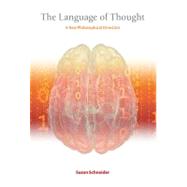
| Preface | p. ix |
| Introduction | p. 1 |
| The Central System as a Computational Engine | p. 27 |
| Jerry Fodor's Globality Challenge to the Computational Theory of Mind | p. 65 |
| What LOT's Mental States Cannot Be: Ruling out Alternative Conceptions | p. 91 |
| Mental Symbols | p. 111 |
| Idiosyncratic Minds Think Alike: Modes of Presentation Reconsidered | p. 135 |
| Concepts: A Pragmatist Theory | p. 159 |
| Solving the Frege Cases | p. 183 |
| Conclusion | p. 229 |
| References | p. 233 |
| Index | p. 249 |
| Table of Contents provided by Ingram. All Rights Reserved. |
The New copy of this book will include any supplemental materials advertised. Please check the title of the book to determine if it should include any access cards, study guides, lab manuals, CDs, etc.
The Used, Rental and eBook copies of this book are not guaranteed to include any supplemental materials. Typically, only the book itself is included. This is true even if the title states it includes any access cards, study guides, lab manuals, CDs, etc.